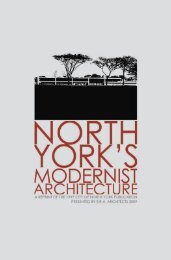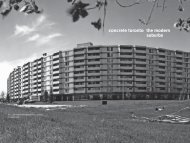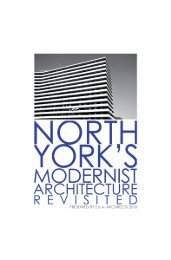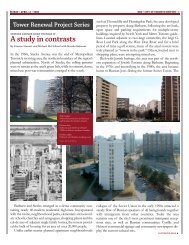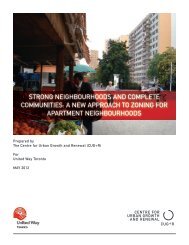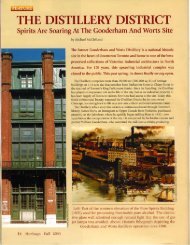A Map of Toronto's Cultural Facilities - ERA Architects Inc.
A Map of Toronto's Cultural Facilities - ERA Architects Inc.
A Map of Toronto's Cultural Facilities - ERA Architects Inc.
Create successful ePaper yourself
Turn your PDF publications into a flip-book with our unique Google optimized e-Paper software.
7.0 Further Potential Analysis<br />
7.1 Additional Comparisons <strong>of</strong> the City’s Four Service Districts<br />
The analysis in Section 6 consists <strong>of</strong> preliminary observations which demonstrate the potential<br />
for this database to produce an array <strong>of</strong> data which can inform the Culture Division about the<br />
health <strong>of</strong> culture and cultural facilities in the City. This information can be used to identify<br />
patterns and trends or the potential for development. This information can also be useful in<br />
looking at the clustering effect <strong>of</strong> cultural facilities and their impact in leveraging resources,<br />
generating economic impact and addressing social, cultural and community issues.<br />
Additional questions to ask that would be helpful in identifying patterns or co-relating information<br />
include:<br />
> How many facilities have more than one role?<br />
> What role does the clustering <strong>of</strong> cultural facilities play in defining a neighbourhood or<br />
district?<br />
> Where are cultural clusters predominantly located?<br />
> What defines cultural clusters (i.e. amount <strong>of</strong> cultural facilities within a certain range,<br />
the composition <strong>of</strong> cultural facility clusters and their respective roles, accessibility to<br />
transportation and space)?<br />
> What city-owned opportunities (libraries, community centres, parks, civic centres,<br />
etc.) exist for future programming uses?<br />
> How many cultural space opportunities (schools, places <strong>of</strong> worship, bookstores, etc.)<br />
exist in each district and how might they be utilized?<br />
> What type <strong>of</strong> cultural space opportunities (schools, places <strong>of</strong> worship, bookstores, etc.)<br />
exist for future programming uses?<br />
The cultural facilities map will be able to provide answers to the quantitative questions raised<br />
above. The map however is not designed to provide answers to the more difficult subjective<br />
and qualitative questions that will probably flow from the answers to the above questions.<br />
Examples <strong>of</strong> such questions include:<br />
> What makes a community work and how are clusters for cultural growth nurtured<br />
and stimulated ?<br />
> Why are some cultural facilities more successful in serving their constituency than others?<br />
> How can the City <strong>of</strong> Toronto leverage its cultural facilities in order to attract private<br />
sector resources?<br />
Clearly, the questions lead to more questions and to opportunities to examine what elements<br />
contribute to successful cultural clusters or to a dearth <strong>of</strong> cultural facilities in specific parts <strong>of</strong><br />
<strong>Cultural</strong> Facility Analysis page 24 <strong>of</strong> 27




